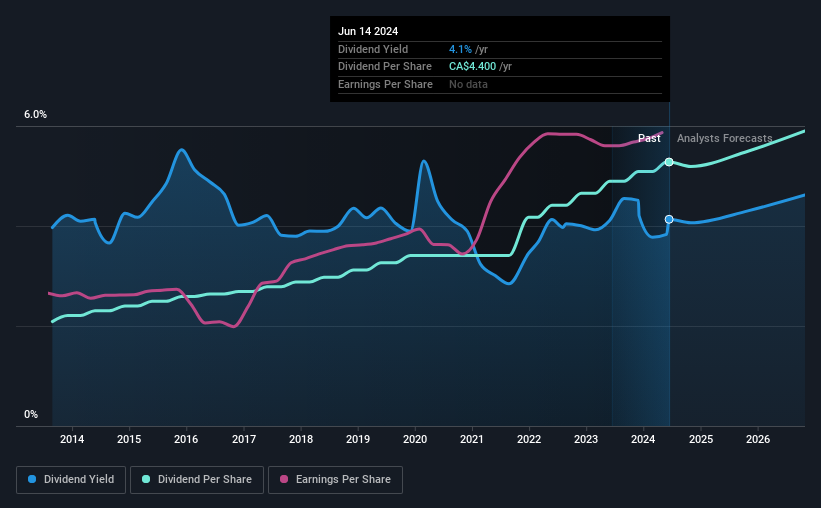National Bank of Canada (TSE:NA) Is Increasing Its Dividend To CA$1.10
The board of National Bank of Canada (TSE:NA) has announced that it will be paying its dividend of CA$1.10 on the 1st of August, an increased payment from last year's comparable dividend. This makes the dividend yield about the same as the industry average at 4.1%.
View our latest analysis for National Bank of Canada
National Bank of Canada's Dividend Forecasted To Be Well Covered By Earnings
We aren't too impressed by dividend yields unless they can be sustained over time.
Having distributed dividends for at least 10 years, National Bank of Canada has a long history of paying out a part of its earnings to shareholders. Past distributions do not necessarily guarantee future ones, but National Bank of Canada's payout ratio of 43% is a good sign as this means that earnings decently cover dividends.
Over the next 3 years, EPS is forecast to expand by 4.2%. Analysts estimate the future payout ratio will be 45% over the same time period, which is in the range that makes us comfortable with the sustainability of the dividend.
National Bank of Canada Has A Solid Track Record
The company has a sustained record of paying dividends with very little fluctuation. The annual payment during the last 10 years was CA$1.74 in 2014, and the most recent fiscal year payment was CA$4.40. This works out to be a compound annual growth rate (CAGR) of approximately 9.7% a year over that time. Companies like this can be very valuable over the long term, if the decent rate of growth can be maintained.
We Could See National Bank of Canada's Dividend Growing
The company's investors will be pleased to have been receiving dividend income for some time. National Bank of Canada has impressed us by growing EPS at 9.8% per year over the past five years. The company is paying a reasonable amount of earnings to shareholders, and is growing earnings at a decent rate so we think it could be a decent dividend stock.
National Bank of Canada Looks Like A Great Dividend Stock
Overall, a dividend increase is always good, and we think that National Bank of Canada is a strong income stock thanks to its track record and growing earnings. Earnings are easily covering distributions, and the company is generating plenty of cash. All of these factors considered, we think this has solid potential as a dividend stock.
Investors generally tend to favour companies with a consistent, stable dividend policy as opposed to those operating an irregular one. However, there are other things to consider for investors when analysing stock performance. Earnings growth generally bodes well for the future value of company dividend payments. See if the 7 National Bank of Canada analysts we track are forecasting continued growth with our free report on analyst estimates for the company. Is National Bank of Canada not quite the opportunity you were looking for? Why not check out our selection of top dividend stocks.
Have feedback on this article? Concerned about the content? Get in touch with us directly. Alternatively, email editorial-team (at) simplywallst.com.
This article by Simply Wall St is general in nature. We provide commentary based on historical data and analyst forecasts only using an unbiased methodology and our articles are not intended to be financial advice. It does not constitute a recommendation to buy or sell any stock, and does not take account of your objectives, or your financial situation. We aim to bring you long-term focused analysis driven by fundamental data. Note that our analysis may not factor in the latest price-sensitive company announcements or qualitative material. Simply Wall St has no position in any stocks mentioned.
Have feedback on this article? Concerned about the content? Get in touch with us directly. Alternatively, email editorial-team@simplywallst.com

 Yahoo Finance
Yahoo Finance 
